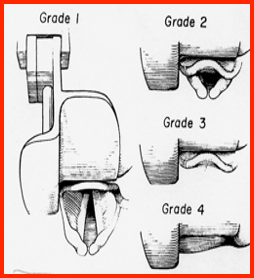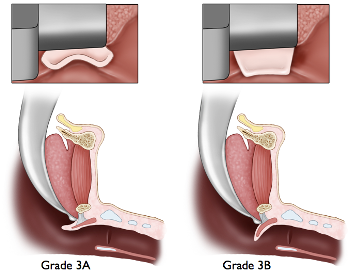Confirmation
Download PDF
Open All
PR15: Tracheal Tube Introducer
Applicable To
Introduction
The tracheal tube introducer (bougie) is a tool to assist with the placement of an endotracheal tube into the trachea in cases where an optimal view cannot be obtained on direct laryngoscopy after lifting the head, performing extralaryngeal manipulation, or both.
Indications
Although bougies may be used in virtually all scenarios, they are intended primarily for patients who demonstrate a Grade 3A Cormack-Lehane view on laryngoscopy: the epiglottis is upturned and the arytenoid cartilages may or may not be visible. They can also be helpful in patients with Grade 2 views to assist in tube placement.


Contraindications
Patients with Grade 3B or 4 views; paramedics should not “fish” with the bougie in search for the glottic opening and the trachea.
Procedure
- Introduce the coudé tip of the bougie from the right corner of the patient’s mouth.
- Advance the bougie towards the midline, beneath the epiglottis, while attempting to keep the distal tip in contact with the posterior surface of the epiglottis.
- A slight “pop” or distinct tactile change may be felt when the bougie passes through the glottic opening. Two separate tactile phenomena will allow paramedics to confirm the bougie is in the trachea rather than the esophagus:
- Once the bougie has passed through the vocal cords, a fine “clicking” sensation may be felt as the bougie tip rubs against the cartilage rings in the trachea. (Some operators describe this as a “sandpaper” feeling of the bougie.)
- With continued advancement, the bougie will eventually “hang up” in a smaller distal airway. In most patients, this will occur around the 30 cm mark. If the bougie can be advanced further than 30 or 35 cm, it is very likely in the esophagus. Once “hold up” has been achieved, the bougie should be withdrawn to around the 25 cm mark (i.e., out of the smaller distal airways and bronchi and back into the trachea).
- The endotracheal tube can be advanced over the bougie and into the trachea. Hold the laryngoscope in position during this process; do not remove the blade until the cuff on the endotracheal tube is inflated. Continued laryngoscopy will help the endotracheal tube to advance into the trachea.
- Common problems with bougie use include:
- Failure to access the trachea. This is often the result of the bougie becoming caught on a vocal fold. To resolve, rotate the bougie to the left or right while maintaining forward pressure.
- Failure to advance the endotracheal tube. This is often caused by the bevel of the endotracheal tube catching on the right vocal fold. Hold the laryngoscope in position and rotate the tube counter-clockwise by 90°; this will direct the bevel away from the right fold and allow smoother passage. If this fails to allow the tube to advance, consider a smaller tube size.